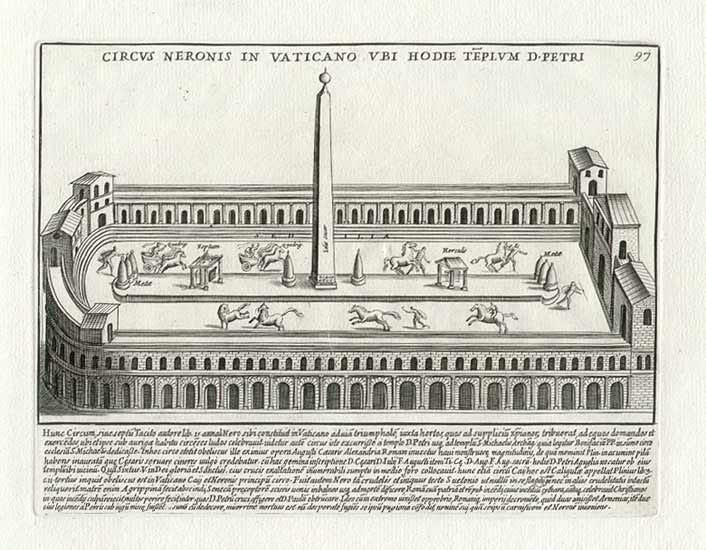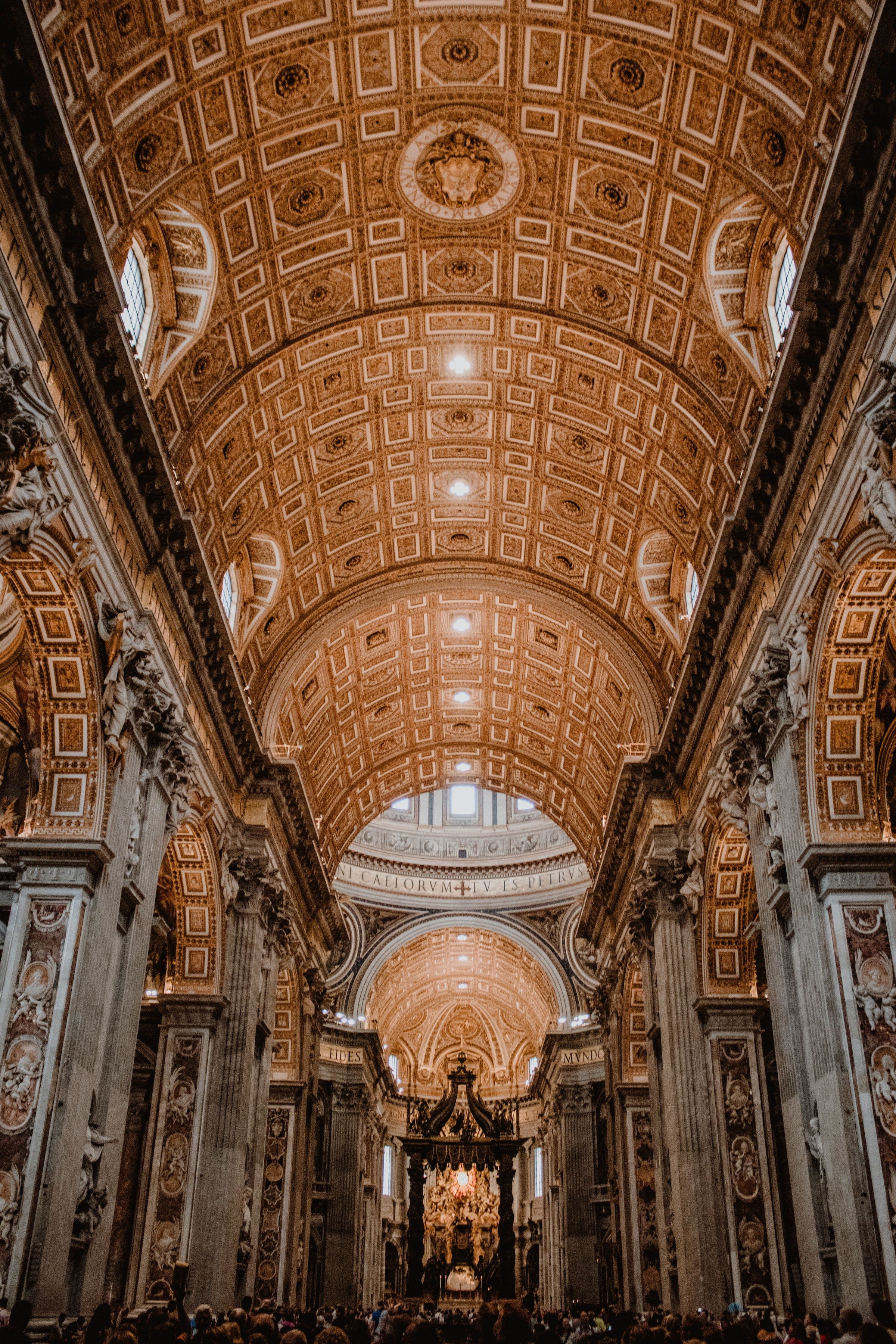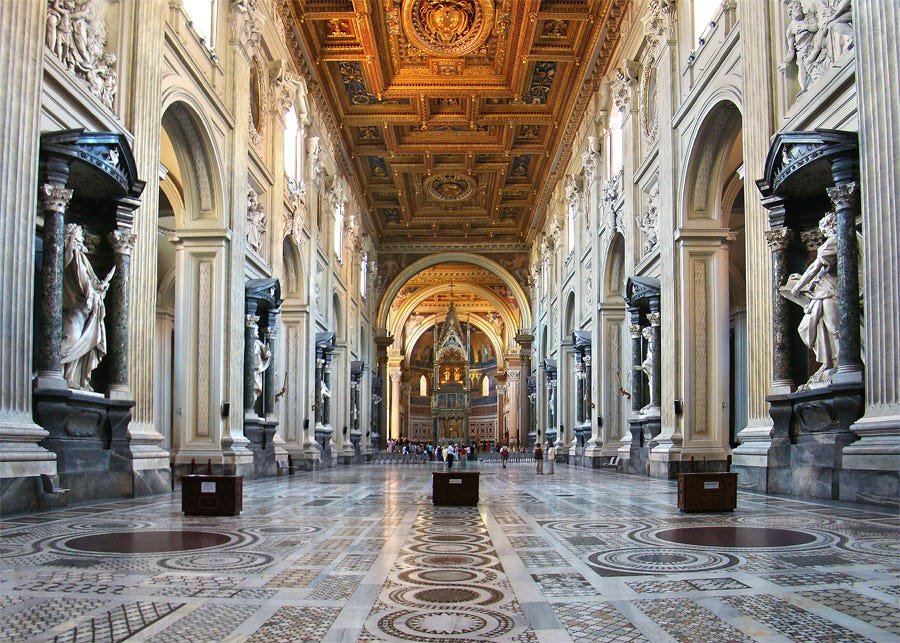Vatican City—3 Historical Places to Visit
Origins: The Romans
During the time of the Roman Republic the area between the Tiber river and the Vatican Hill was known as Ager Vaticanus (Vatican territory).
As Rome grew into an Empire this area was transformed into a residential district for important Roman families. Granddaughter of Augustus (first Emperor of Rome) Agrippina the Elder built gardens here in the first century AD. Her son and Emperor Caligula began building a Circus here, to be completed by Emperor Nero.
Drawing of the Circus of Nero by Pietro Santi Bartoli (1699)
Inside sits an obelisk taken from Heliopolis an ancient city in Egypt by Caligula and is the only visible element of this Roman Circus that exists today.
In 64 AD there was the Great Fire of Rome. It was in this Circus just after the Great Fire where the apostle Saint Peter was crucified. The obelisk bore witness to the martyrdom of Saint Peter and other early Christians.
In 313 AD Roman Emperor Constantine signed the Edict of Milan and proclaimed the tolerance of Christianity within the Roman Empire.
Shortly after, Constantine ordered the construction of a church on the site where Saint Peter was said to be buried.
This brings us to our first building.
1. St. Peter’s Basilica
Atop the Vatican Hill is where construction of the first Basilica over Saint Peter’s tomb began in 315 AD.
Dedicated to the first Bishop of Rome (the Pope) Saint Peter’s tomb is directly under the Altar of the Confession. The huge church with a nave, four aisles, and a four-sided porticoed atrium was not completed until 326 AD. And it has been one of the most sacred sites of Christianity ever since.
A brief history
After this construction the area surrounding the basilica was built up and the popes acquired property nearby.
In the 5th century after the fall of the Western Roman Empire the popes’ influence strengthened. Their stronghold became the capital of the Papal States from 756-1870. During the 8th century Pope Leo III protected Vatican City by encircling it with walls.
However, the walls were torn down by the Romans after his death. Leo IV added new walls and created an independent district. But the Popes continued to reside outside of Vatican city in the Lateran District of Rome and even briefly moved the papacy to Avignon, France in the 14th century.
The New St. Peter’s Basilica
It was during this time that the old basilica was neglected and in the 15th century fell into disrepair.
The New St. Peter’s Basilica began under Pope Julius II who commissioned Donato Bramante to design a new building with the intent that it was to be a beacon of Christendom. In 1506 Pope Julius II laid the first stone.
Saint Peter’s Basilica - Unsplash @maeva_vgr
A magnificent work of Renaissance architecture it was designed with the help of many famous architects including Michelangelo, Giacomo della Porta, and Carlo Maderno among others.
Designed to be the focal point of Christianity with a length measuring 720ft (220m) and dome 448ft (136.6m) tall.
Inside are two of the most famous sculptures. The Pietà completed by 25-year old Michelangelo begun when he was only 22 years old. And Bernini’s Baldacchino the largest bronze monument ever built, the high Baroque canopy weighing 81,400 pounds.
Bernini’s Baldacchino - Unsplash @britozour
Many people mistakenly think St. Peter’s Basilica is a Cathedral. However, because it’s not the seat of the Bishop it’s not a Cathedral.
The Cathedral of the pope as Bishop of Rome and the most superior church of the Catholic Church (including superior to Saint Peter’s Basilica) is our next building.
Let’s dive in.
2. Archbasilica of Saint John Lateran
The mother church of the Catholic Church was founded in 324 and is the oldest public church in Rome.
Although it lies outside Vatican City walls it is still property of the Holy See and holds extraterritorial status from Italy. It stands adjacent to the Lateran Palace gifted to the Bishop of Rome by Constantine I. Every Pope beginning in 311 occupied the Lateran Palace until the French Pope moved the papacy to Avignon in 1309.
Borromini’s basilica showing the niches with apostles - CC 4.0 @Tango7174
Both the archbasilica and the Lateran Palace were damaged in fires in the 14th century.
Pope Sixtus V began reconstructing the archbasilica in the 16th century. Further renovations were carried out by leading Baroque architect Francesco Borromini in the 17th century. He created 12 niches that were eventually filled by sculptures of the Apostles decades later.
The Scala Sancta (Holy Stairs) feature white marble steps inside wooden ones. These are supposedly the stairs that were sanctified by Jesus during his Passion. The steps were brought from Jerusalem to the Lateran Palace by Constantine’s mother Saint Empress Helena in the 4th century. The steps were relocated in the 16th century to their present location by Pope Sixtus V.
The Scala Sancta (Holy Stairs) - CC 4.0 @Fallaner
It was an earlier Pope Sixtus that brings us to our next building.
3. The Sistine Chapel
Back within the world’s smallest nation-state of the Vatican City, the Sistine Chapel was commissioned by Pope Sixtus IV in 1473 who gave it its namesake.
Today this private papal chapel is the site of the papal conclave, where a new pope is chosen. The interior is what draws visitors in with its renowned High Renaissance frescoes. Most famously are the masterpieces of Michelangelo.
Ceiling of the Sistine Chapel - CC 3.0 Antoine Taveneaux
From 1508-1512 Michelangelo concentrated on the barrel-vaulted ceiling that includes nine paintings covering an area of 8610sf (800sm).
He completed this nearly singlehandedly and only 23 years later he returned to the chapel and created The Last Judgment (1535-41) on the wall behind the altar. The chapel is also home to works by Sandro Botticelli including the The Trials of Moses and other notable Renaissance artists.
Sandro Botticelli’s The Trials of Moses
Raphael was commissioned to design tapestries to be hung in the chapel. Although some have been damaged they were restored and presented behind glass. Today these magnificent tapestries can be seen on a rotating display during special ceremonies.
19th century and beyond
Vatican City remained the capital of the Papal States until 1870 when Rome was annexed by Italian forces. In February of 1929 the Lateran Treaty between the Holy See and the Kingdom of Italy was signed. Today with a population of around 500 people it remains a beacon of Christianity and home to artistic and architectural masterpieces.
Deep dives
This overview barely scratched the surface. To dive into the two thousand year history of the Papacy and chronicles of the most significant Popes start with Absolute Monarchs: A History of the Papacy by John Julius Norwich.
The Vatican: Secrets and Treasures of the Holy City written by church historian Michael Collins is a beautifully illustrated behind the scenes look into the Vatican.
To learn more about the compelling life of Michelangelo check out The Agony and the Ecstasy: A Biographical Novel of Michelangelo by Irving Stone.
For additional insight into Rome check out the previous article Rome—3 Historical Places to Visit.
*As an Amazon Associate I may earn a small commission from qualifying purchases at no extra cost to you.








